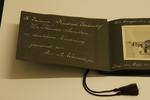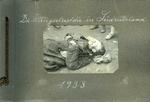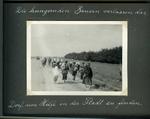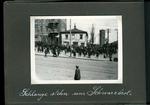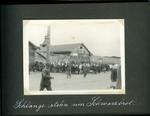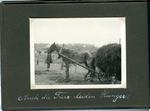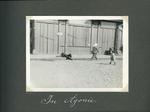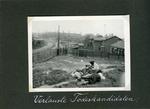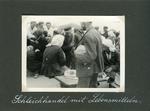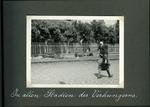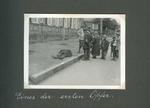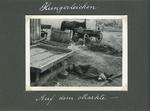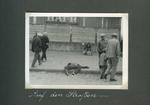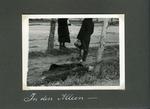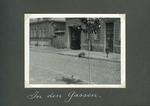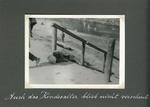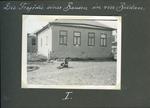Alexander Wienerberger: Innitzer Album
Records
Results
- This statement appears on the inside of the front cover to an album with the title: Die Hungertragödie in Südrussland 1933 [The Tragedy of Famine in South Russia 1933.] Also known as “The Innitzer alThis statement appears on the inside of the front cover to an …
- Photo source: Wienerberger, Alexander. Die Hungertragödie in Südrussland 1933; also known as the Innitzer Album, 1934. Album cover insert. This is one of 25 photographs depicting life and death in anPhoto source: Wienerberger, Alexander. Die Hungertragödie in Südrussland 1933; also known as …
- Photo source: Wienerberger, Alexander. Die Hungertragödie in Südrussland 1933; also known as the Innitzer Album, 1934. p.1. This is one of 25 photographs depicting life and death in and around KharkiPhoto source: Wienerberger, Alexander. Die Hungertragödie in Südrussland 1933; also known as …
- Photo source: Wienerberger, Alexander. Die Hungertragödie in Südrussland 1933; also known as the Innitzer Album, 1934. P.2. This is one of 25 photographs depicting life and death in and around KharkiPhoto source: Wienerberger, Alexander. Die Hungertragödie in Südrussland 1933; also known as …
- Photo source: Wienerberger, Alexander. Die Hungertragödie in Südrussland 1933; also known as the Innitzer Album, 1934. p.3. This is one of 25 photographs depicting life and death in and around KharkiPhoto source: Wienerberger, Alexander. Die Hungertragödie in Südrussland 1933; also known as …
- Photo source: Wienerberger, Alexander. Die Hungertragödie in Südrussland 1933; also known as the Innitzer Album, 1934. p.4. This is one of 25 photographs depicting life and death in and around KharkiPhoto source: Wienerberger, Alexander. Die Hungertragödie in Südrussland 1933; also known as …
- Photo source: Wienerberger, Alexander. Die Hungertragödie in Südrussland 1933; also known as the Innitzer Album, 1934. p.5. This is one of 25 photographs depicting life and death in and around KharkiPhoto source: Wienerberger, Alexander. Die Hungertragödie in Südrussland 1933; also known as …
- Photo source: Wienerberger, Alexander. Die Hungertragödie in Südrussland 1933; also known as the Innitzer Album, 1934. p.6. This is one of 25 photographs depicting life and death in and around KharkiPhoto source: Wienerberger, Alexander. Die Hungertragödie in Südrussland 1933; also known as …
- Photo source: Wienerberger, Alexander. Die Hungertragödie in Südrussland 1933; also known as the Innitzer Album, 1934. p.7. This is one of 25 photographs depicting life and death in and around KharkiPhoto source: Wienerberger, Alexander. Die Hungertragödie in Südrussland 1933; also known as …
- Photo source: Wienerberger, Alexander. Die Hungertragödie in Südrussland 1933; also known as the Innitzer Album, 1934. p.8. This is one of 25 photographs depicting life and death in and around KharkiPhoto source: Wienerberger, Alexander. Die Hungertragödie in Südrussland 1933; also known as …
- Photo source: Wienerberger, Alexander. Die Hungertragödie in Südrussland 1933; also known as the Innitzer Album, 1934. p.9. This is one of 25 photographs depicting life and death in and around KharkiPhoto source: Wienerberger, Alexander. Die Hungertragödie in Südrussland 1933; also known as …
- Photo source: Wienerberger, Alexander. Die Hungertragödie in Südrussland 1933; also known as the Innitzer Album, 1934. p.10. This is one of 25 photographs depicting life and death in and around KharkPhoto source: Wienerberger, Alexander. Die Hungertragödie in Südrussland 1933; also known as …
- Photo source: Wienerberger, Alexander. Die Hungertragödie in Südrussland 1933; also known as the Innitzer Album, 1934. p.11. This is one of 25 photographs depicting life and death in and around KharkPhoto source: Wienerberger, Alexander. Die Hungertragödie in Südrussland 1933; also known as …
- Photo source: Wienerberger, Alexander. Die Hungertragödie in Südrussland 1933; also known as the Innitzer Album, 1934. p.12. This is one of 25 photographs depicting life and death in and around KharkPhoto source: Wienerberger, Alexander. Die Hungertragödie in Südrussland 1933; also known as …
- Photo source: Wienerberger, Alexander. Die Hungertragödie in Südrussland 1933; also known as the Innitzer Album, 1934. p.13. This is one of 25 photographs depicting life and death in and around KharkPhoto source: Wienerberger, Alexander. Die Hungertragödie in Südrussland 1933; also known as …
- Photo source: Wienerberger, Alexander. Die Hungertragödie in Südrussland 1933; also known as the Innitzer Album, 1934. p.14. This is one of 25 photographs depicting life and death in and around KharkPhoto source: Wienerberger, Alexander. Die Hungertragödie in Südrussland 1933; also known as …
- Photo source: Wienerberger, Alexander. Die Hungertragödie in Südrussland 1933; also known as the Innitzer Album, 1934. p.15. This is one of 25 photographs depicting life and death in and around KharkPhoto source: Wienerberger, Alexander. Die Hungertragödie in Südrussland 1933; also known as …
- Photo source: Wienerberger, Alexander. Die Hungertragödie in Südrussland 1933; also known as the Innitzer Album, 1934. p.16. This is one of 25 photographs depicting life and death in and around KharkPhoto source: Wienerberger, Alexander. Die Hungertragödie in Südrussland 1933; also known as …
- Photo source: Wienerberger, Alexander. Die Hungertragödie in Südrussland 1933; also known as the Innitzer Album, 1934. p.17. This is one of 25 photographs depicting life and death in and around KharkPhoto source: Wienerberger, Alexander. Die Hungertragödie in Südrussland 1933; also known as …
- Photo source: Wienerberger, Alexander. Die Hungertragödie in Südrussland 1933; also known as the Innitzer Album, 1934. p.18. This is one of 25 photographs depicting life and death in and around KharkPhoto source: Wienerberger, Alexander. Die Hungertragödie in Südrussland 1933; also known as …






